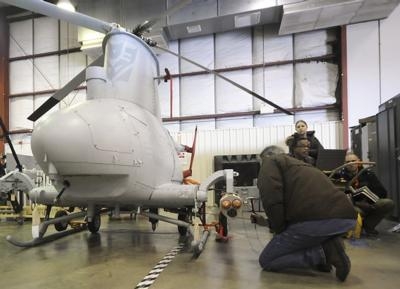Sun, Mar 25, 2012
Navy Requests Weaponized MQ-8B, First For The Service
The U.S. Navy for the first time has reqested that one of its unmanned aircraft be configured to carry weapons. The Navy plans to arm the MQ-8B Fire Scout with a laser-guided rocket, the Advanced Precision Kill Weapon System (APKWS), in just 18 months.

Typically, this type of development would take two to three years at a minimum, according to Jeremy Moore, Fire Scout weapons system integration lead. Arming the Fire Scout with a guided rocket will enable the fleet to engage hostile threats with the Fire Scout independent of air support from carrier or shore-based aircraft. This capability will keep the warfighter out of harm’s way, he said.
The Fire Scout team and NAVAIR’s structures rotary-wing division personnel conducted the first of a series of tests March 7 on the newly installed hardware, which will gauge how the system will operate in the shipboard environment.
“This is the very first weaponization program on this aircraft,” said Moore. Part of the Rapid Deployment Capability (RDC) acquisition process, “it was identified by the fleet as an urgent need for joint forces, so we are pressing forward as hard as we can to get it out there.”
Bill McCartney, Fire Scout’s Air Vehicle flight test lead, said the weaponization of any aircraft is an intricate process, particularly it in this case since it is the first time the Navy will arm an unmanned aircraft. “We had a very tight timeline to conduct trade studies and complete design reviews,” McCartney said. “Now, we are starting to execute tests, and there is little time in the schedule for repeats.”
The team planned this test event to get an early look at the new hardware design installed on the aircraft, allowing them to identify any issues before beginning ground and flight tests later this year. Ground and flight tests will be conducted by Naval Air Warfare Center’s Aircraft Division and Weapons Division personnel at Webster Field and China Lake, Calif., with support from NAVAIR, Naval Sea Systems Command and industry partners.
“This is the first stepping stone,” Moore said. “We are trying to build in the capability to add on additional weapons in the future.” (Photo provided by NAVAIR)
More News
He Attempted To Restart The Engine Three Times. On The Third Restart Attempt, He Noticed That Flames Were Coming Out From The Right Wing Near The Fuel Cap Analysis: The pilot repor>[...]
Make Sure You NEVER Miss A New Story From Aero-News Network Do you ever feel like you never see posts from a certain person or page on Facebook or Instagram? Here’s how you c>[...]
From 2009 (YouTube Edition): Leading Air Show Performers Give Their Best Advice for Newcomers On December 6th through December 9th, the Paris Las Vegas Hotel hosted over 1,500 air >[...]
Aero Linx: NASA ASRS ASRS captures confidential reports, analyzes the resulting aviation safety data, and disseminates vital information to the aviation community. The ASRS is an i>[...]
“For our inaugural Pylon Racing Seminar in Roswell, we were thrilled to certify 60 pilots across our six closed-course pylon race classes. Not only did this year’s PRS >[...]
 NTSB Final Report: Rutan Long-EZ
NTSB Final Report: Rutan Long-EZ ANN FAQ: Turn On Post Notifications
ANN FAQ: Turn On Post Notifications Classic Aero-TV: ICAS Perspectives - Advice for New Air Show Performers
Classic Aero-TV: ICAS Perspectives - Advice for New Air Show Performers ANN's Daily Aero-Linx (06.28.25)
ANN's Daily Aero-Linx (06.28.25) Aero-News: Quote of the Day (06.28.25)
Aero-News: Quote of the Day (06.28.25)



